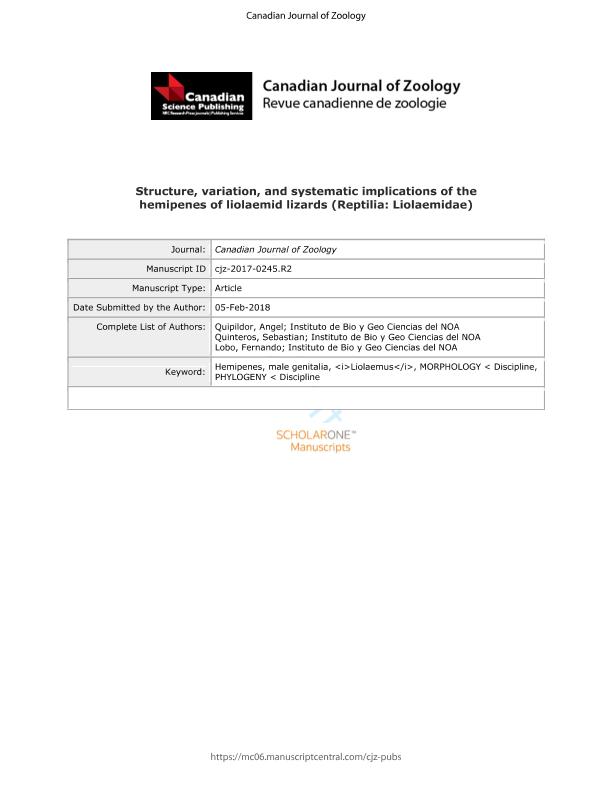Mostrar el registro sencillo del ítem
dc.contributor.author
Quipildor, Angel Matías

dc.contributor.author
Quinteros, Andres Sebastian

dc.contributor.author
Lobo Gaviola, Fernando Jose

dc.date.available
2019-12-06T17:27:46Z
dc.date.issued
2018-02
dc.identifier.citation
Quipildor, Angel Matías; Quinteros, Andres Sebastian; Lobo Gaviola, Fernando Jose; Structure, variation, and systematic implications of the hemipenes of liolaemid lizards (Reptilia: Liolaemidae); National Research Council Canada-NRC Research Press; Canadian Journal of Zoology; 96; 9; 2-2018; 987-995
dc.identifier.issn
0008-4301
dc.identifier.uri
http://hdl.handle.net/11336/91643
dc.description.abstract
The structure of copulatory organs is widely used in systematics for both differentiating species and for studying phylogenetic relationships. We describe the hemipenes of 42 species belonging to the genus Liolaemus, representing most of their internal groups. We reported 42 characters, the majority not published previously. We constructed a metatree based on previously proposed phylogenetic studies and optimized the hemipenial characters in this topology. Among the most informative characters are presence or absence of flounces or calyces on the sulcate face, ornamentation of the apex, presence or absence of an asulcate face prominence, and presence of a thickening on the proximal region of the asulcate face. Furthermore, we performed a phylogenetic analysis exclusively with the hemipenial characters, not with the intention of making a phylogeny based on this single set of characters, but rather to demonstrate their significance for the reconstruction of relationships in Liolaemus. The obtained results show that the main clades are recovered. We also compared the hemipenial morphology between closely related species to evaluate its taxonomic importance. We conclude that in Liolaemus, the hemipenes can be used both for the differentiation of species and to provide additional evidence for establishing their phylogenetic relationships.
dc.format
application/pdf
dc.language.iso
eng
dc.publisher
National Research Council Canada-NRC Research Press

dc.rights
info:eu-repo/semantics/openAccess
dc.rights.uri
https://creativecommons.org/licenses/by-nc-sa/2.5/ar/
dc.subject
HEMIPENES
dc.subject
LIOLAEMUS
dc.subject
MALE GENITALIA
dc.subject
MORPHOLOGY
dc.subject
PHYLOGENY
dc.subject.classification
Zoología, Ornitología, Entomología, Etología

dc.subject.classification
Ciencias Biológicas

dc.subject.classification
CIENCIAS NATURALES Y EXACTAS

dc.title
Structure, variation, and systematic implications of the hemipenes of liolaemid lizards (Reptilia: Liolaemidae)
dc.type
info:eu-repo/semantics/article
dc.type
info:ar-repo/semantics/artículo
dc.type
info:eu-repo/semantics/publishedVersion
dc.date.updated
2019-10-18T18:24:04Z
dc.journal.volume
96
dc.journal.number
9
dc.journal.pagination
987-995
dc.journal.pais
Canadá

dc.journal.ciudad
Otawa
dc.description.fil
Fil: Quipildor, Angel Matías. Consejo Nacional de Investigaciones Científicas y Técnicas. Centro Científico Tecnológico Conicet - Salta. Instituto de Bio y Geociencias del NOA. Universidad Nacional de Salta. Facultad de Ciencias Naturales. Museo de Ciencias Naturales. Instituto de Bio y Geociencias del NOA; Argentina
dc.description.fil
Fil: Quinteros, Andres Sebastian. Consejo Nacional de Investigaciones Científicas y Técnicas. Centro Científico Tecnológico Conicet - Salta. Instituto de Bio y Geociencias del NOA. Universidad Nacional de Salta. Facultad de Ciencias Naturales. Museo de Ciencias Naturales. Instituto de Bio y Geociencias del NOA; Argentina
dc.description.fil
Fil: Lobo Gaviola, Fernando Jose. Consejo Nacional de Investigaciones Científicas y Técnicas. Centro Científico Tecnológico Conicet - Salta. Instituto de Bio y Geociencias del NOA. Universidad Nacional de Salta. Facultad de Ciencias Naturales. Museo de Ciencias Naturales. Instituto de Bio y Geociencias del NOA; Argentina
dc.journal.title
Canadian Journal of Zoology

dc.relation.alternativeid
info:eu-repo/semantics/altIdentifier/doi/https://doi.org/10.1139/cjz-2017-0245
dc.relation.alternativeid
info:eu-repo/semantics/altIdentifier/url/https://www.nrcresearchpress.com/doi/10.1139/cjz-2017-0245#.XeqO_JNKiUk
Archivos asociados
